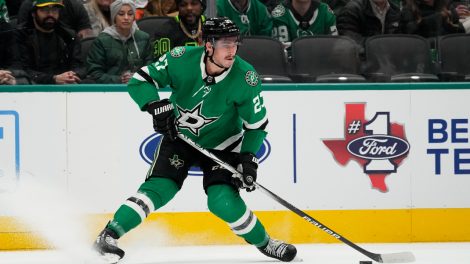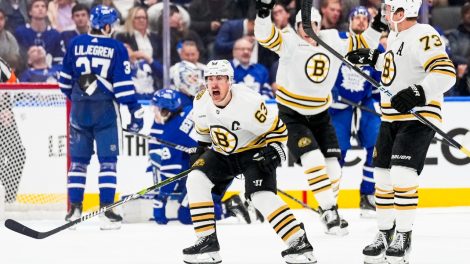TORONTO – How Auston Matthews ended up centring a line of all kids is that he never wanted the easy way out.
His coach, Mike Babcock, defines a specific role for each individual player early and likes to stick to the plan. Babcock also likes pairs of forwards, even though we think of them as trios. This is why Chris Kunitz owns an Olympic gold medal.
Entering the Toronto Maple Leafs’ 2016-17 season—one destined to become a happy memory in this city regardless of Round 1’s outcome—Babcock knew he wanted to pair veterans Tyler Bozak and James van Riemsdyk on a line and Nazem Kadri and Leo Komarov on another.
The coach and the lottery prize had a talk. They considered smoothing the teenager’s learning curve by placing him on the wing and easing him into the middle—a common NHL development strategy that worked for stars like Tyler Seguin and Steven Stamkos.
Jonathan Toews didn’t take that path, though. Neither did Sidney Crosby, nor Connor McDavid. Matthews did not want to play on anybody’s wing.
“He wants to be the best player in the world,” Babcock said.
So with the other pairs in stone and rookies flooding the roster, the coach saw little choice but to flank Matthews with Zach Hyman and Connor Brown (since swapped for William Nylander).
“There wasn’t a whole bunch more options,” Babcock said. “Hyman and Brown, as much as they’re kids, they’re dependable.
“Even though you don’t consider them veterans, they’re veteran-like people with veteran-like habits because they do it right all the time. I don’t consider it – I think that line is a load, and I think it’s a good line.”
Good line? Maybe in Game 1 and early in Game 2. But since then, and especially during Monday’s 4-3 OT beauty, the Hyman-Matthews-Nylander trinity were Corsi gods. Five-on-five, their possession metrics were 75%, 71.4% and 82%, respectively.
Matthews scored his first playoff goal as a professional (the wunderkind went 0-fer in the 2016 Swiss post-season), and he and Hyman did the dirty work to set Nylander up for his first NHL playoff goal as well.
The Washington Capitals had no answer for them.
“Matty’s an elite skill guy. He can play with or without the puck against anybody. Hyman comes every day as dependable as dependable is. Comes with more energy than anybody, I think, in the league. Great forechecker, makes great passes from under the goal line. And Willy can pass it, he can shoot it, he can skate,” Babcock said.
“They’re a better line for us because we’ve got Naz and we’ve got Bozie. That’s what’s good about having three centres like that—they can pick each other up.”
Let’s go beyond the kids’ goals for a moment and rewind to the first two games of the series, when Matthews—one of the NHL’s most prolific shooters—actually blocked more shots (six) than he took (five) over his 46 minutes of ice time.
“Look at the blocks, too,” Brian Boyle said. “Some heavy shots, and he’s opening up and it hits him in some tender areas. He took one I know that hurt, and he did the same thing right away without thinking—the very next period.
“That’s what I think he prides himself on, playing a complete game. He’s done enough interviews when he’s said that. Many can say that, but he goes out and does it. He’s competitive, he works, he has takeaways [three already this series]—that’s a skill that takes a while to learn. At 19 years old, that’s impressive. His mental approach, his maturity—that’s what it speaks to.”
Has Matthews, a guy accustomed to having the puck glued to his stick, ever blocked so many pucks?
“I dunno. Everybody’s sacrificing their body. It’s all an investment,” Matthews said.
“The playoffs are an investment. Not everything is about goals or assists. It’s about finishing checks, blocking shots, the little things that go unnoticed behind the scenes that help your team win.”
When Barry Trotz visited Toronto at the top of the month, the Capitals’ coach described Matthews as a “generational player” four times, then indirectly compared him to Neo out of The Matrix.
“He’s deceptively fast,” Trotz said. “He has this ability to see and do things at a high rate of speed, but I know in his mind everything’s slow. He is able to see everything in slow motion.”
So on Monday when he streaks up the gut, wrists a puck that caroms off John Carlson’s stick, bonks off Nate Schmidt’s visor and bounces in front of Braden Holtby, Matthews stays with it for the finish. Maybe there’s luck in that play, but there’s something else, too.
“We give him respect, first and foremost,” Kevin Shattenkirk says. “Most importantly, we know he works hard. He doesn’t give up. He makes second and third efforts.”
That’s the scariest part, and Washington needs a solution fast.
“Toronto has a special one,” Boyle said.
[relatedlinks]
How the Washington Capitals are trying to solve the Auston Matthews’ line
We surveyed several members of the Capitals on how they’re trying to limit the awesome Matthews line.
Kevin Shattenkirk: “They’re similar to the way we play, to be honest. Marcus Johansson is similar to Nylander. They’re always on the move—that’s the thing you need to realize about them. They may not be overly physical on the forecheck, but they keep their speed, and that allows them to have an effective forecheck. They’re not hitting you off the puck; they’re anticipating where it’ll be. That can be tough.”
Jay Beagle: “A lot of speed and youth. Good with the puck. Great vision. They’re good down low. Sometimes with the young kids, you can push them off the puck more. That’s something where usually something has to develop in their game. But that line, it seems they’re very well developed. A hard line to play against.”
Matt Niskanen: “We’re not going out of our way to shadow him or anything ridiculous like that…. He’s got a lot of tools. I haven’t seen a skill he can’t do yet. He’s got size and reach, vision, strong on his skates, hockey sense, and he can score. A lot of tools. He had a fantastic year. Forty goals, right? He didn’t play like a rookie, as most of those special players don’t.”
Braden Holtby: “I just try to read, react. You look at tendencies of how the puck comes off his stick, what directions, not where he shoots but how he releases. The more you play against him, you realize whose stick it is. The hardest part with young guys coming in is, you see Crosby’s stick and you know who that is. The more you play him, the more you recognize him on the ice.”









